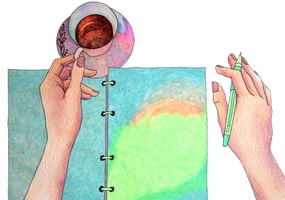Awareness of Thought

“The soul becomes dyed with the colour of its thoughts.”
Marcus Aurelius - Meditations
The next blog posts will focus on three discrete areas of awareness: thought, emotion, and bodily sensation. To increase your personal agency and make lasting change, try to achieve the briefest pause between an experience and your next move. In that brief pause you can decide whether to go forward with your usual, default behavior or to do something else. This requires awareness and deliberation, in the moment.
I will start with awareness of thought which is admittedly a huge topic, with hundreds or thousands of books, articles, podcasts and apps covering it over the ages.
A few years ago, I would have told you that I mostly operated via rational thought, with little emotion and almost zero bodily awareness in the mix. I once did a team-building exercise at work in which we had to draw a visualization of ourselves – I drew a brain on two legs. That’s how strongly I used to identify with my thoughts and the idea of thinking in general. (Plus, please note that I only had legs, apparently no other body).
As humans, many of us have a constant talk track going in our heads. This talk track provides everything from inane commentary on each moment to seriously critical noise and self-doubt or old stories that still color our picture of the world and our experiences in life.
Humans are meaning-making machines, so we are naturally inclined to make up stories. This tendency has survival benefits, because when you’ve noticed a threatening predator in the past, it is wise to be able to quickly recollect that experience when you see a rustling in the bushes. However sometimes the wind is just blowing, there is no predator, and the meaning you’ve automatically made should be questioned. Inspecting these stories brings us back to reality, and then we can let our curiosity lead us instead.
Here are some common patterns of thought for me, and the ways I’ve dealt with them in the moment:
Thought: Old stories about how things work: “Fred always does that thing”.
Meta-thought: Does he? Does that matter right now? Does that mean you have to react in your usual way in this moment?
Thought: Cultural tropes: A PROPER LADY would do things this way.
Meta-thought: Jeebs, patriarchy, get out of my head.
Thought: Inane things like ear worms. I have an inner playlist. Of one song. On repeat endlessly throughout the day. I call her DJ RebRock.
Meta-thought: DJ RebRock, can we please spin a happier tune than Black Hole Sun today?
Thought: Endlessly reworking the past or worrying about the future.
Meta-thought: Enjoying the sun shining in the here-and-now is pretty nice.
To get to the bottom of this reality for you, you have to figure out how to make your own thoughts more visible to yourself. There are a few techniques that I’ve found helpful in increasing my awareness of thought:
Meditation. There is a common misapprehension that meditation is intended to quiet your thoughts. Most meditation approaches are actually just trying to bring awareness to thoughts, emotions and bodily sensations. A helpful metaphor is that thoughts are like passing like clouds in the sky. They come without bidding and pass through in a moment or two. Labeling my thoughts when I see them arise is also helpful: for instance “comparing” comes up a lot for me, as does “worry”. I just mentally note that this category of thought has come up and then lightly observe it as it passes through my mind.
Journaling. I cannot say enough good things about the practice of journaling. I write something in my journal most mornings, just to get my present thoughts and emotions out of my head and onto the page, so I can inspect them. As an analytical person I also love having a record my thoughts and emotions over time, so I can see the trends.
Doing an activity without simultaneous input. For me that’s crocheting or going for a run without listening to a podcast. These are simple activities that occupy my body, which allows my thoughts and emotional tenor to float up so I can see what’s going on for me more explicitly. I also do these things most every day.
These are all forms of sitting with myself, without other inputs, and seeing what comes up. What would this look like for you? What’s coming up for you right now, in this moment, while you read this? That is where to start.
Resources:
- Short: Interview with Michael Singer, author of Untethered Soul.
- Medium: The 10% Happier My favorite starter meditation app – great tutorials and educational series on the theory behind meditation.
- Long: Untethered Soul by Michael Singer – the seminal work on the fact that we are not our thoughts. Highly practical and relatable.



